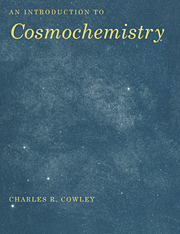Book contents
- Frontmatter
- Contents
- Foreword
- 1 Overview
- 2 Minerals: An Introduction to the Nomenclature and Chemistry
- 3 A Brief Introduction to Petrology
- 4 A Résumé of Thermodynamics and Statistical Mechanics
- 5 Condensation Sequences and the Geochemical Classification of the Elements
- 6 The Theory of the Bulk Composition of the Planets
- 7 Meteorites and the Standard Abundance Distribution (SAD)
- 8 An Introduction to Isotope Geology with an Emphasis on Meteorites
- 9 Some Concepts from Nuclear Physics
- 10 Energy Generation in Stars and Nucleosynthesis
- 11 Atomic and Molecular Spectra
- 12 The Analysis of Stellar Spectra
- 13 The Chemistry of Stars and Stellar Systems
- 14 Cold, Non-stellar Material in Galaxies
- 15 Emission-Line Regions and their Chemical Abundances
- 16 Abundances of the Elements in Galaxies
- Appendix
- References
- Index
2 - Minerals: An Introduction to the Nomenclature and Chemistry
Published online by Cambridge University Press: 05 June 2012
- Frontmatter
- Contents
- Foreword
- 1 Overview
- 2 Minerals: An Introduction to the Nomenclature and Chemistry
- 3 A Brief Introduction to Petrology
- 4 A Résumé of Thermodynamics and Statistical Mechanics
- 5 Condensation Sequences and the Geochemical Classification of the Elements
- 6 The Theory of the Bulk Composition of the Planets
- 7 Meteorites and the Standard Abundance Distribution (SAD)
- 8 An Introduction to Isotope Geology with an Emphasis on Meteorites
- 9 Some Concepts from Nuclear Physics
- 10 Energy Generation in Stars and Nucleosynthesis
- 11 Atomic and Molecular Spectra
- 12 The Analysis of Stellar Spectra
- 13 The Chemistry of Stars and Stellar Systems
- 14 Cold, Non-stellar Material in Galaxies
- 15 Emission-Line Regions and their Chemical Abundances
- 16 Abundances of the Elements in Galaxies
- Appendix
- References
- Index
Summary
Introduction
The chemical composition of matter is often the result of factors which, at first, are not at all obvious. Consider the following examples. In certain very stable stellar atmospheres a separation of the chemical elements can take place. One might think that the heavier elements would be the first to sink with respect to the abundant hydrogen, which forms the bulk of (most) stellar matter. In the earth's upper atmosphere, for example, there is a region where the heavy species sink. The number density of a given species roughly follows the law for an isothermal atmosphere, N ∝ exp(–z/H), where z is the altitude, and H the scale height, H = ℜT/gμ. (See the Index for the meaning of symbols not explained in the text.) Thus molecules such as O2 and N2 are concentrated at low altitudes relative to atomic hydrogen and helium.
For the stars in question, the situation is not so simple. There is a competing, upward force due to radiation pressure that can overwhelm gravity. Given time, exotic heavy elements such as mercury or platinum can be pushed up from the envelope of a star and concentrated in the photosphere, where they may be revealed by spectroscopy. In these stars, the abundant, light elements have a tendency to sink! We shall discuss this counterintuitive process in some detail in Chapter 13, since much of the writer's own research has been concerned with its observational consequences.
- Type
- Chapter
- Information
- An Introduction to Cosmochemistry , pp. 9 - 26Publisher: Cambridge University PressPrint publication year: 1995

